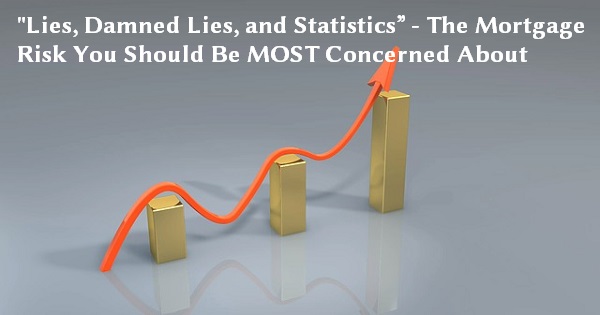“Lies, Damned Lies, and Statistics” – The Mortgage Risk You Should Be MOST Concerned About

Over 100 years ago, Mark Twain popularized the phrase, “Lies, damned lies and statistics.” It’s a saying that describes how people often try to bolster a weak argument using the persuasive power of numbers and statistics.
I see this trick used often in commentary surrounding the finance industry. Misinformation and the twisting of statistics are used to create fear in the general population.
I recently read one such research report called State of the Nation – Spotlight on Finance Risk by Roy Morgan. Here is one of the more widely publicized headlines from this report:
“Over 700,000 Australians with a Home Loan Potentially at Risk”
Wow, that sounds horrific!
But how did the researchers reach this conclusion? Is it a realistic conclusion they made strictly from their research, or did they also include some opinion-based insights?
What Exactly Does “At Risk” Mean?

This exaggerated claim originates from a statement in the original report claiming 17.4 percent of homeowners, or 705,000 people, are “at risk” on the mortgages tied to their personal residences.
How they define “at risk” is not particularly clear. The report states they based this figure on an average interest rate of 5.4 percent and “the ability of borrowers to meet the repayment guidelines currently provided by the major banks based on the amount originally borrowed.”
See what I mean? You may need to read that again to get your head around it.
It’s obviously hard to pick this claim apart when there is no objective basis for exactly how the researchers determined which borrowers were “at risk” of experiencing mortgage stress. However, we can address the average interest rate used, and also the way lenders determine the ability of borrowers to service loans.
An Interest Rate Reality Check
As a starting point, virtually no one is paying an interest rate near 5.4 percent. Currently we are writing owner-occupier loans as low as 3.59 percent, and most lenders are offering products near the 4 percent mark. Click here to learn more about PropertyInvestingFinance.com’s special wholesale investor rates.
We should also note that lenders generally use benchmark rates of between 7 and 8 percent when determining a potential borrower’s ability to service a loan. Unless there is a change in the borrower’s income, or some outside factor comes into play, like extravagant spending or other debts, there should be no reason for borrowers to experience mortgage stress.
The report goes on to state, “The August rate reduction to 5.25 percent is likely to reduce mortgage stress marginally, but this will ultimately depend on how borrowers react to it, particularly in relation to whether the drop in interest rate encourages increased borrowings.”
This might be true, but it has no relevance to a research report, unless there is some statistical basis for the conclusion. As you might expect, there is none offered.
Mortgages and Income Duality: An Interesting Side of Modern Life

According to the report, two-income households now hold 67.2 percent of owner-occupier mortgages. While there is a statistical basis to this figure that seems reasonable, the conclusions that follow make little sense.
The report states:
“9.3 percent of dual-income households are classified as “at risk” of mortgage stress, even if it’s the non-main earner who drops out of the workforce.”
If this figure is correct, and there is no reason to suggest it’s not, then it sounds like a reason for optimism to me. A different perspective to this stat is the reality that over 90 percent of leveraged, dual income households would be fine if the lower income earner ceased employment.
This is not the angle that the media has taken, despite the fact that the report went on to conclude:
“There are 3.2 million mortgage holders – 67.2 percent of the total – who are in dual-income households, and as a result have lower-than-average mortgage risk levels.”
The Real Mortgage Holder Risks May Surprise You
It’s obvious that a reduction in income is likely to be an issue for some mortgage holders, but what is left out of this discussion are the potential reasons why this is happening, the likelihood of it happening, and what preparations mortgage holders can make to reduce their financial risks.
Unemployment in Australia is low and has been for many years, including during the recent Global Financial Crisis. Statistics show joblessness is especially uncommon amongst those between the ages of 24 and 55, and even less likely for those in skilled occupations. Moreover, in the current economy, the vast majority of people who lose their jobs go on to find new employment within a matter of months.

In truth, well over 50 percent of the jobless will find work within two months. Only around five percent of those who lose their jobs will remain unemployed for more than six months. The prognosis for the majority of mortgage holders, who are mostly between the ages of 24 and 55 and in skilled employment, is far better.
The greatest danger to mortgage holders, in terms of losing income, is the risk of an illness or injury. Research consistently brings up these two factors as the major causes of mortgage defaults that lead to foreclosure and repossession of houses.
The insistence of the mainstream media to misunderstand or ignore the information available on the real risks to mortgage holders has resulted in a public that is unaware of, and not prepared for the greatest dangers to their wealth and lifestyle. Studies by various companies and the government continually show that Australians are drastically underinsured when it comes to personal insurances such as life, disability, trauma and income protection.
An Australian Life Insurance company published research that illustrates the gulf between the public’s perceptions and the realities when it comes to the risks of not being able to continue earning income. The startling statistics show:
- 89 percent consider they are not likely to have an accident that will make them unable to work in the next 20 years.
- 80 percent said they were not likely to suffer a serious illness in the next 20 years.
- 83 percent did not expect to pass away in the next 20 years.
You only have to consider the rate of cancer in our society to realize these beliefs are far removed from reality. Approximately one-third of women and one quarter of all men will suffer from cancer at some stage in their lifetimes.
Unfortunately, many of the people who answered this survey will be proven wrong. If they are not insured against such events, the results may be catastrophic financially, both for them and their family members.
Are You Underinsured?
Almost every working Australian has a level of life insurance cover within their superannuation, but the default option in most superannuation plans is rarely sufficient, particularly for those with mortgages. As an example, according to a survey by the Australian Institute of Superannuation Trustees (AIST) and Industry Funds Forum (IFF), out of every two industry fund members, one was underinsured by at least $100,000.
Specifically, results of the survey showed that:
 50 percent are underinsured by $100,000 for life insurance.
50 percent are underinsured by $100,000 for life insurance.- 74 percent are underinsured by $100,000 for Total and Permanent Disability (TPD).
- 45 percent are underinsured by $1,000 a month for income protection.
The same survey found that 81 percent of people hold a perception that life insurance is too expensive. It also turns out that 61 percent of people overestimate the cost.
To be sure that you’re not underestimating your life insurance need and not overestimating the cost of protecting your family, get in touch with me here to obtain your personal no-obligation needs assessment.
Comments
Got something to say? Post a comment...
You must be logged in to post a comment.

 50 percent are underinsured by $100,000 for life insurance.
50 percent are underinsured by $100,000 for life insurance.



Don’t believe the official unemployment figures. To be counted as unemployed, you must:
(a) Be available to work during the period; and
(b) Have worked exactly zero hours during the period.
If you’re sick or caring for a relative and were not available to work, you weren’t unemployed. If you did one hour of paid work, you were employed, according to the government.
The real statistic to pay attention to is underemployment (including unemployment). Closer to 20% of Australians are underemployed. Wages growth has been virtually stagnant for years, but house prices continue to rise, fuelled by ridiculously low interest rates and speculators. When the average family can’t afford the average home, something’s gotta give. It’s a bubble, and it will do what bubbles do.
All the big banks are already reporting increasing levels of mortgages which are more than 90 days in arrears. It only takes a small percentage of the market to cause a widespread panic.
There’s another GFC coming, and this one will be much worse than the last one. There’s a lot more debt in the system in 2016 than there was in 2008.
Hi Michael,
Thanks for your contribution. I don’t necessarily disagree with anything you have stated, except that you have to put any statistic on unemployment into the context of mortgage holders, if that is the topic. If you do this the unemployment and underemployment rates amongst mortgage holders are far lower than in the general population and employed people generally find new employment relatively easy to find. It’s not that this isn’t a risk, its just far less of a risk than losing income due to an illness or accident. This is the point of the article, and also because you can insure against this risk and most property investors do not do this adequately.
With regard to the next GFC, I have no doubt that this is inevitable, but don’t discount the ability of Governments and Central banks to hold this off for a very long time.
Hi I agree with both of you – I come from a family of long term property developers 3 brothers and 30,000 blocks later here we are still playing I,m 81 P is 79 B is 76. recently I personally carried out a survey on “Take Home Pay” of women working in a Gold Coast major shopping centre, canvassing those working in the smaller shops where I found one wgo took home 740?wk with the others taking home between $600/660 week 70% had a working partner and visualised their earnings as an extra contribution, the remainder were trying to live as a single person on this money, 5 had another job and also had kids all of which pointed to a “Tough Gig”. I also agree that another drop is coming and agree on two years and believe me experience has shown you had better respect such forth-coming or pay a price, yes we did but we are living proof that you don’t die from it and we are talking 7 digits, big 7 digits Property makes more “ordinary people” (had coffee one on one with George Soros that’s what he called it) wealthy than any other medium of investing and I have the past clients to prove it – keep up the good work, haven’t found anything to criticise so all you young ones out there “Listen Up” Ronnie